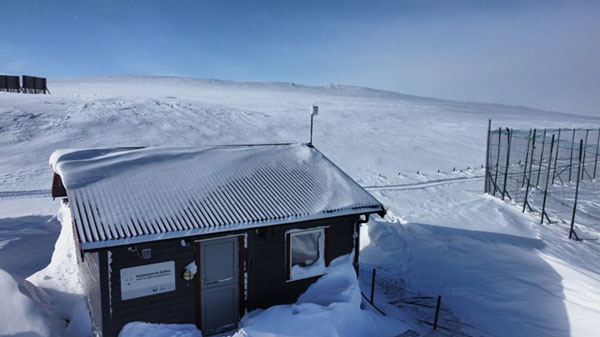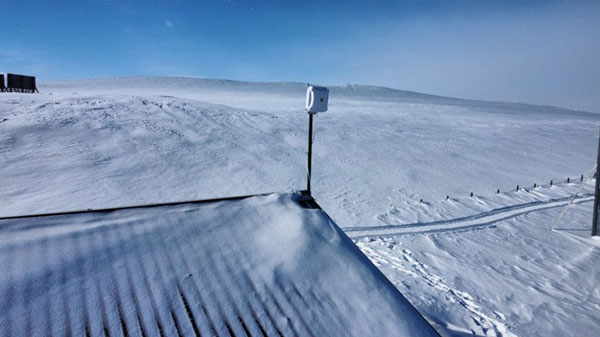Connecting for Conservation


We have recently found out that The Arctic Fox Foundation in Norway makes use of a POYNTING antenna to enhance their connectivity from their remote research facility. The breeding facility is extremely remote, in the northern parts of Scandinavia. This area is subject to brutal weather such as high-density snow and extreme cold temperatures. The only way to get to the research facility in the winter is by using a snowmobile.
Heading up the facility in Norwayis Craig Jackson whois originally from South Africa. He grew up in Phalaborwa, a town just outside the Western bquotation of the Kruger National Park. This is where he gained his keen interest for nature conservation which propelled him into a path of studying Zoology, completing his PhD through the Norwegian University of Science and Technology.
Craig’s wife is Norwegian and that is why they have decided to make Norway their home and how he came to work with the Arctic Fox Foundation.
Craig and his family recently visited South Africa to see his old friends and family. As part of this trip, he could not resist spending a few nights in the Kruger National Park again. Craig’s cousin Brandon Mitchell, accompanied by Cameryn Froneman, joined him on this vacation to the Kruger National Park. Craig was surprised to hear that Cameryn had done some student vacation work for POYNTING, as he knows the brand well and has recently purchased a POYNTING antenna for the research facility. It is once again great to see how small the world can be, and that POYNTING Antennas are being used in such an admirable conservation effort.
Craig makes use of the XPOL-2 antenna to communicate data to scientists. He acquired another antenna for live streaming the cute foxes for everyone who is interested. The live stream helps monitor the foxes in their remote camp and shares the success of the Arctic Fox Project. The data is used by the scientists to improve the success of the project and do valuable research. To check out the live stream click the link: https://youtube.com/live/qh_47P1rKkE?feature=share


Background
The Arctic fox population in Norway was critically endangered with only 40-60 adults remaining in Scandinavia in 2000. To aid in the conservation of this species, a captive breeding facility was established in Sæterfjellet, Norway in 2005. The facility serves as a central component in the long-term conservation efforts for the species in Norway, with captive-bred offspring strategically released into various mountain areas across the country each year.
To date, a total of 460 arctic foxes have been reintroduced into the wild since the first release in 2006. Active management interventions, such as supplementary feeding and culling of red foxes, are also employed in the release sites to support the population.
As of 2020, the Norwegian Arctic fox population was estimated to have reached 302 adults, up from critically low levels. Additionally, the emigration of released individuals into neighbouring Sweden and Finland has helped to bolster the Scandinavian population as a whole, which was estimated to number 452 adults in 2020.

Breeding Facility
The captive breeding facility for Arctic foxes is in their natural habitat and comprises eight large enclosures, each about half the size of a football field. Additionally, a slightly smaller enclosure serves as a temporary holding facility. Each of the enclosures has a minimum of two artificial dens to provide shelter.
Arctic foxes breed once per year, with mating occurring in March. After a gestation period of around 52 days, puppies are born in the dens.
Captive-bred offspring are trapped and transported to designated release sites in January/February each year when they are approximately eight months old. At this stage, they are as large as the adults and no longer dependent on their parents. The foxes are transported from the breeding station to a temporary holding facility near Oppdal, where they receive a health check and parasite medication before being transported to their designated release sites. To improve their survival rate post-release, supplementary feeding stations and artificial dens are provided at the release sites. To date, captive-bred foxes have been successfully reintroduced into nine different populations across Norway.
POYNTING Antennas for Connectivity
The Norwegian Institute for Nature Research (NINA), use a POYNTING XPOL-2 antenna to stay connected at the remote site. The XPOL-2, a wideband 2×2 MIMO 4G/5G antenna that has been extensively used in Norway, is employed at the base camp. The XPOL-2 antenna has gained popularity in the Scandinavian region and has proven to be reliable in the harsh and freezing conditions.
For those interested in learning more about POYNTING’s range of antennas in Norway, please contact Emcom or check out the XPOL-2 Antenna here.

